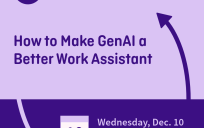This blog post is an excerpt from our new report “The Importance of Visibility to the End User Experience.” Download the full report here.
IT staff require visibility into the end user experience when employees use apps in the cloud, on mobile devices or virtually. But getting a detailed look at how things are running across different environments is difficult at best, and administrators have often relied on a hodgepodge of tools that fall short.
What’s needed is a centralized view that pulls information from all sources.
The following are some of the main challenges that highlight the need for application performance management (APM) in government.
1. Poor end user experience: Agency employees struggle with outdated technology and work environments that can’t respond quickly to changing mission needs. Line of business and IT departments struggle to clearly identify productivity constraints and validate technology investments. Citizens are challenged by the inability to successfully interact with important government services via digital channels due to less-than-optimal application performance, digital service project delays and budget constraints. Overall, poor user experience deters agencies from achieving their mission. You can’t improve user experience without clearly understanding how end users interact with your internal and external applications.
2. Measuring cloud service SLAs: The federal government relies increasingly on cloud-based applications such as Microsoft Office 365, Salesforce, ServiceNow and other Software-as-a-Service (SaaS) offerings. The provider typically owns the applications, and delivers them according to a service level agreement (SLA). But agencies often have limited monitoring capabilities using provider tools, which can hinder the timely identification of issues and troubleshooting. When performance or availability issues occur, an agency may not be able to easily determine if the provider is meeting SLA obligations.
3. Integration into existing processes: A monitoring solution must seamlessly integrate into existing processes, such as IT ticketing systems and security logging systems. Many agencies also look for ways to incorporate more end user self-service, such as building automated remediation responses for simple troubleshooting, to reduce help desk workloads.
4. Capacity planning and performance analysis: Applegate emphasizes the need for “a regular cadence” in using analytics for more accurate capacity planning and performance analysis, which is difficult to master without the proper tools. But extracting maximum value from monitoring and achieving a cycle of continuous improvement is extremely beneficial to agencies.
Given these challenges, agencies need a comprehensive solution that provides application monitoring, integration with existing services and deep visibility into the end user experience.
The Solution: Application Performance Management
Application performance management is the solution to ensuring a positive end user experience. By investing in an APM solution, agencies can proactively monitor the end user experience of any local, cloud, web or enterprise mobile app running on any physical, virtual or mobile device.
This level of monitoring allows agencies to identify and rapidly resolve problems to ensure the efficient delivery of digital services to citizens and high levels of workforce productivity for government employees. Insights gained from APM also help agency leads make smarter operational decisions, which can directly impact the mission.
An important step in APM implementation is identifying key business applications and how to instrument them. Instrumenting an application means enabling it to be monitored and its performance to be measured. Think of APM instrumentation like a heart monitor of sorts. Agents, which are small, lightweight programs, actually monitor applications. The APM management tool reads gathered data and then alerts administrators when an application is not operating normally. It also helps diagnose errors and provides a plethora of performance metrics.
After baselines are established, APM looks for performance problems or constraints in applications, infrastructure and end user devices. For example, APM may detect that an application is running slower than usual because there’s not enough available memory or disk space. APM points to the problem, enabling staff to modify processes to speed up transactions.
APM can also measure user productivity. The system monitors user actions, such as creating a new record or submitting a report, providing even deeper visibility into how applications perform and respond. Another benefit of monitoring at this level is the ability to inventory software based on how it’s actually used by end users rather than where it’s installed. Armed with this data, administrators can renegotiate end user license agreements (EULAs) with vendors to potentially reduce costs.
Finally, APM data can support a continuous improvement process to identify targeted changes to be made to specific business transactions. As a result, agencies can reduce labor costs, if necessary, while providing citizen services more efficiently.







Leave a Reply
You must be logged in to post a comment.